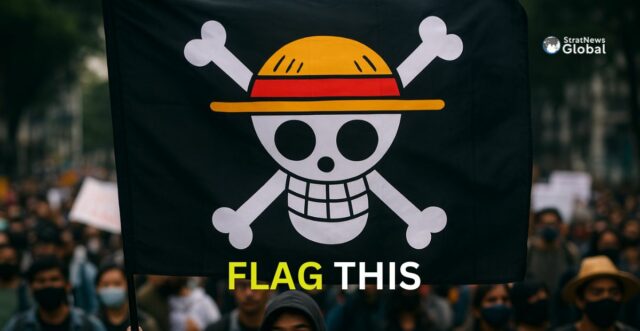A skull in a straw hat might not sound like a political threat. But in parts of Asia and Europe, the pirate flag from the hit Japanese anime One Piece has turned into an unlikely symbol of protest.
First introduced in 1997 by manga creator Eiichiro Oda, One Piece has become one of the most successful franchises in the world, with over 520 million copies sold and more than 1,100 TV episodes. At the heart of the series is Monkey D. Luffy, a carefree but determined pirate whose Jolly Roger—the skull-and-crossbones adorned with his trademark straw hat—represents defiance, loyalty, and the quest for freedom.
That symbol has now sailed into real-world politics. In Indonesia, protesters angry at President Prabowo Subianto’s increasingly centralised rule have waved the anime flag at rallies, painted it on walls, and even draped it from vehicles. The government, far from amused, has branded the flag divisive. Lawmakers have warned that flying it next to Indonesia’s national colours could even amount to treason, carrying penalties of up to five years in prison.
The backlash has only added to the flag’s allure. When students at the University of the Philippines Diliman marched against corruption, they carried the same straw-hatted skull, images of which quickly went viral on social media. And on September 10, French demonstrators protesting President Emmanuel Macron’s austerity measures held up hand-drawn versions of the flag, some donning straw hats for emphasis.
In Nepal, the ‘Gen Z’ protestors were seen waving the One Piece flag with some carrying the slogans “#WakeUpNepal” and ‘Nepo Babies’, underscoring a generation’s demand for accountability and change. What began as a youth-led protest soon swelled into a movement strong enough to topple the government, leading to the prime minister’s resignation.
What makes the anime flag resonate across borders is precisely its lack of political baggage. It is not tied to a party or ideology. Instead, it speaks to a shared cultural memory among Millennials and Gen Z who grew up with One Piece. Its meaning is universal: resistance against oppression, rebellion against corruption, and a demand for freedom.
Officials may dismiss it as juvenile, but the imagery is potent. By co-opting a pop culture icon, young protesters are reframing activism itself—creative, global, and instantly recognisable. The message needs no words: a straw hat on a skull is enough.
As Amnesty International has urged, governments should pay less attention to banning symbols and more to addressing the grievances behind them. Because for today’s youth, protest doesn’t just come with placards and slogans—it comes with anime, memes, and flags that tell their own story.





